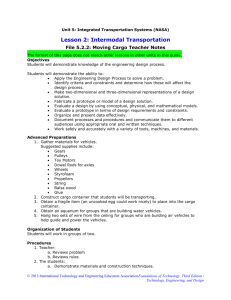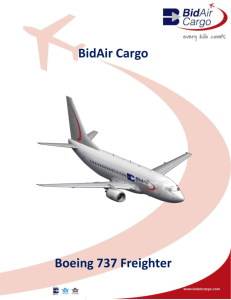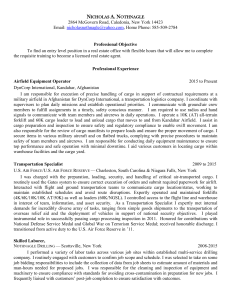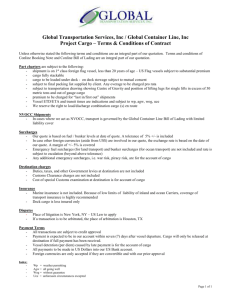1. introduction
advertisement
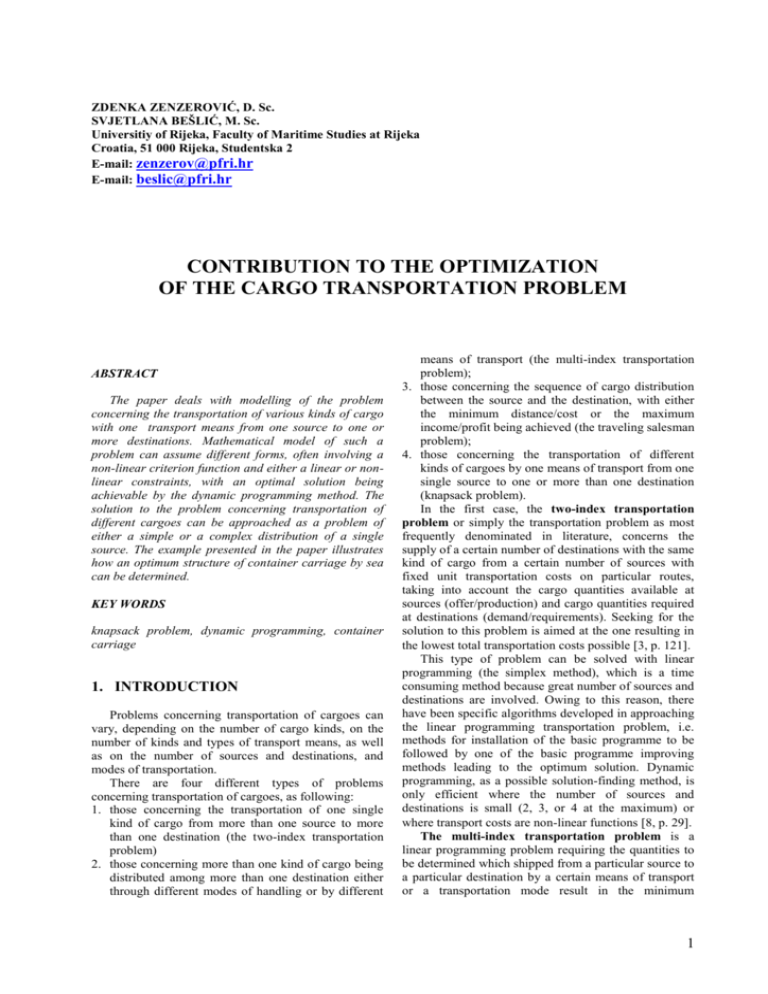
ZDENKA ZENZEROVIĆ, D. Sc. SVJETLANA BEŠLIĆ, M. Sc. Universitiy of Rijeka, Faculty of Maritime Studies at Rijeka Croatia, 51 000 Rijeka, Studentska 2 E-mail: zenzerov@pfri.hr E-mail: beslic@pfri.hr CONTRIBUTION TO THE OPTIMIZATION OF THE CARGO TRANSPORTATION PROBLEM ABSTRACT The paper deals with modelling of the problem concerning the transportation of various kinds of cargo with one transport means from one source to one or more destinations. Mathematical model of such a problem can assume different forms, often involving a non-linear criterion function and either a linear or nonlinear constraints, with an optimal solution being achievable by the dynamic programming method. The solution to the problem concerning transportation of different cargoes can be approached as a problem of either a simple or a complex distribution of a single source. The example presented in the paper illustrates how an optimum structure of container carriage by sea can be determined. KEY WORDS knapsack problem, dynamic programming, container carriage 1. INTRODUCTION Problems concerning transportation of cargoes can vary, depending on the number of cargo kinds, on the number of kinds and types of transport means, as well as on the number of sources and destinations, and modes of transportation. There are four different types of problems concerning transportation of cargoes, as following: 1. those concerning the transportation of one single kind of cargo from more than one source to more than one destination (the two-index transportation problem) 2. those concerning more than one kind of cargo being distributed among more than one destination either through different modes of handling or by different means of transport (the multi-index transportation problem); 3. those concerning the sequence of cargo distribution between the source and the destination, with either the minimum distance/cost or the maximum income/profit being achieved (the traveling salesman problem); 4. those concerning the transportation of different kinds of cargoes by one means of transport from one single source to one or more than one destination (knapsack problem). In the first case, the two-index transportation problem or simply the transportation problem as most frequently denominated in literature, concerns the supply of a certain number of destinations with the same kind of cargo from a certain number of sources with fixed unit transportation costs on particular routes, taking into account the cargo quantities available at sources (offer/production) and cargo quantities required at destinations (demand/requirements). Seeking for the solution to this problem is aimed at the one resulting in the lowest total transportation costs possible 3, p. 121. This type of problem can be solved with linear programming (the simplex method), which is a time consuming method because great number of sources and destinations are involved. Owing to this reason, there have been specific algorithms developed in approaching the linear programming transportation problem, i.e. methods for installation of the basic programme to be followed by one of the basic programme improving methods leading to the optimum solution. Dynamic programming, as a possible solution-finding method, is only efficient where the number of sources and destinations is small (2, 3, or 4 at the maximum) or where transport costs are non-linear functions 8, p. 29. The multi-index transportation problem is a linear programming problem requiring the quantities to be determined which shipped from a particular source to a particular destination by a certain means of transport or a transportation mode result in the minimum 1 transport costs. Where the problem is defined in this way, we are dealing with the three-index transportation problem which can be solved by means of the gradual cargo distribution method or by the multiplicator method, that is to say just like the two-index transportation problem, by means of methods for installation and improvement of the basic programme, an optimum solution being also achievable by means of the simplex method 13, p. 230. The traveling salesman problem belongs to the narrower class of non-linear programming called the integer one, particularly the 0-1 programming. In the performance of cargo distribution, care should be taken that starting from the 0-point of departure visitings include a number of scheduled points of destination with known distances between them as well as their visiting order, in dependence on the criterion applied, results either in the minimum distance/time consumption or in the maximum income/profit earned. The two-index transportation problem having been described in detail in literature and widely applied already, the multi-index transportation problem having been presented in Z. Zenzerović's paper 13 before, and the commercial traveller problem being the one occupying H. Pašagić, at the Faculty of Transportation Studies 6, this paper deals with the fourth type of cargo transportation problems and with solutions based on the dynamic programming. 2. DEFINITION OF THE TRANSPORTATION PROBLEM CONCERNING CARGOES OF DIFFERENT KINDS The fourth type cargo transportation problem arises when a certain number of consignments of different weights and cargo kinds has to be transported by particular means of transport, e.g.: a truck, ship, plane, railway, etc. Their total weight is not to exceed the maximum weight allowed for the respective means of transport or its carrying capacity. Transportation of different consignments means different profits earned or different transport costs. Profit amounts also depend on specific features of cargo kinds carried and on their share in the total carrying capacity of the respective means of transport. The assumption is that profits obtained from different cargoes can be measured with a common measurement unit, that the profit obtained from one kind of cargo is independent on the distribution of the rest carrying capacity among other kinds of cargo, and finally that the profit total represents the sum of particular profit amounts. The same conclusion is valid for transportation costs. The purpose is to have the available capacity distributed among different kinds of cargo and/or to decide upon the number of single-sort cargo consignments for transportation which will result either in the maximum profit or the minimum costs. The criterion function represents the maximum transportation profit/minimum transportation costs, whereas the constraints refer to the occupancy of the means of transport involved with consignments of particular cargo kinds of different weights. Matemathical model for this type of the problem can take the following forms: a) the criterion function and constraints are expressed by a linear function, b) the criterion function is linear and constraints are non-linear functions, c) the criterion function is non-linear and constraints are either linear or non-linear functions. The problem corresponding to the mathematical model described under a) above is approached by linear programming methods, and/or by the integer linear programming or the dynamic programming method as either the simple or complex distribution problem. In this case linear programming is given priority because practical problems are mostly solved by computers provided with software and also because linear programming makes the postoptimum analysis possible. Where the problem described under b) above is dealt with, its constraints being expressed in non-linear form, linear programming cannot be applied, but the problem is recommended to be approached by the dynamic programming method. This is seldom case in practice because of the linear connection existing between the number of consignments and the weight of particular consignments. In case of the c) the problem may involve a nonlinear criterion function and linear constraints. Where the problems dealt with can be formulated an appropriate mathematical model with at least one or more non-linear links either in function of the target or within the limitation group, the non-linear programming is applied. There have been quite a number of methods developed with the aim of finding solutions to these problems through solutions to particular subclasses of non-linear programming, such as: non-linear programming with a linear constraints, the square, integer, separable, geometrical, and a series of other types of programming with certain forms of non-linear links in their mathematical models. Practical work frequently requires calculations regarding optimum profitability, economy, and productivity which are considered the most significant indicators of commercially successful business operation. These indicators being expressed in the form of fractions, calculations aimed at their maximum, apply the fractioned linear programming method, provided linear form of constraints. Where the transportation problem mathematical model is involved which come down to linear programming, the assumption is that the transport cost (or the profit from transport) on any route is proportional with the goods quantity being transported 2 on the respective route. By this assumption the corresponding criterion function is conditioned to assume linear interdependence. However, it often happens in practice that problems concerning transportation of cargoes refer to the cost or to the profit of non-linear form in relation to the cargo quantity being transported (e.g. rebates on larger quantities). In such cases, the cost/profit related to certain cargo quantities can be given in the form of discrete values and this is where the dynamic programming method should apply. With regard to the mentioned forms of cargo transportation problems, the dynamic programming method is given preference over other possible methods listed before, the main reason arising from the fact that the criterion and the limitation function are not necessarily linear. This way brings us to the dynamic programming essential feature, its limited strictness in terms of the model structural equation (or non-equation) linear form 5, p. 41. The problem concerning transportation of different kinds of cargoes is a typical example for the dynamic programming problem not including the time component, yet owing to its artificial decomposition into a series of cargo kinds corresponding to a series of stages the problem is reduced to a multi-stage process gradually becoming optimized by means of the dynamic programming method. 3. FORMULATION OF MATHEMATICAL MODEL FOR TRANSPORTATION OF DIFFERENT KINDS OF CARGOES Dynamic programming represents one of the operational research methods for determining the decision making optimal strategy concerning multistage processes in cases where correlated decisions are made for particular years within a particular period or for particular activities concerning the formulated problem. By this method the problem is approached through stages in the manner that in each stage estimate the optimum values obtained in the preceding stage are used. This process leading to the sequence of optimal decisions is known as the Bellman principle. For mathematical formulation of the general problem, concerning the optimum planning process, basic terms should be introduced and defined, as following: system, process, multi-stage process, criterion function, policy. System denotes a physical system (technical, economic, etc.) analytically defined as the vector of states 7, p. 214: (1) r(t ) r1(t ), r2 (t ),..., rN (t ) The state vector components r(t) determine the system features, whereas the number N is called the system dimension. Vector r(t) may be marked p, the p denoting the initial state of the system. Process can be described as the system behaviour in the course of time. Where relations with their initial and each subsequent state determined are dealt with 7, p. 214: p0 = p, pn+1 = W(pn); n = 0,1,2,…; W-operator, (2) then the set of vectors (p0, p1,…) represents the system behaviour in discrete moments of time n=1,2,… and is defined as a process, i.e. a special type of process called the multi-stage process. The relation (2) can be also presented in the following way: (3) pn W n ( p) , meaning that operator W has been applied n – times. Accordingly, the multi-stage process is defined by the system p initial state by means of transformation W(p), which can be symbolically presented as: p, W ( p) . Classification of multi-stage processes is the following 9, p. 3-10: Finite and infinite processes (processes with finite/infinite number of states), Discrete and continuous processes (states change in discrete/continuous moments of time), Stationary and nonstationary processes (invariableness/variableness of the system working process during the time), Deterministic and stochastic processes (the process behaviour is completely determined/changeably, transformable). The cargo transportation problem being a process consisting of finit number of steps with state changes taking place within discrete moments of time, the form of transformation (change) does not depend on time and the transformation is completely known (determinined), next paragraphs are going to deal with the following multi-stage processes: finite, discrete, stationary and deterministic processes. An important role within the dynamic programming is played by recursive relations. In respect of function N type G( p ) , provided a known transformation W in i i0 expressions (2) and (3), recursive relations are 7, p. 216: N f N ( p) G( p ), i N 0,1,2,... i 0 i.e. f N ( p ) G( p ) f N 1( p1 ) G( p ) f N 1W ( p ), N 1,2,... (4) The term denoting a multi-stage process, previously defined by the set of vectors p, p1, p2,… and by 3 relation pn W n ( p) , can be extended if another parameter q is introduced in the transformation W, this parameter also depending on time and its selection influencing the process. In that case the process is determined by the set of vectors: (5) pn 1 W ( pn , qn ); n 0,1,2,..., N . Selection of this value (qi) is called determining of the permitted solution. This value is selected with the aim of reaching the optimum solution to function F(p, p1, p2,…; q, q1, q2,…), called the criterion function or the optimization criterion function. The multi-stage process (N-stage) providing the solution is described by set of vectors: p, p1 ,... pn1 ; q0 , q1 ,..., qN , (6) pn1 W ( pn , qn ) za 0 n N The group of permitted solutions q0 , q1..., qn , where qn = qn(p, p1,…, pn; q0, q1,…,qn-1), is called policy. The optimal policy is the one providing the best solution (the maximum or the minimum of a function F). The dynamic programming method is mostly applied to planning and management problems containing the plan structure selection, the realization dynamics and the distribution of resources expressed in natural or value units, provided that a multi-stage process has been dealt with. According to the stage contents, there are two types of problems to be distinguished 9, p.3-2: a) dynamic problems with the time component as a stage (investment optimization, production planning, distribution of resources, management of reserves, maintenance, replacement of equipment), b) non-dynamic problems or problems without the time component, being subject to decomposition to stages according to logical criteria (distribution of resources, transport duties, system reliability, spare parts quantity, shortest route within the network). According to the distribution of resources mode, the dynamic programming problems can be selected in the following two groups: a) simple distribution problems, b) complex distribution problems. The problem solving process with the dynamic programming method is the following: 1) defining the optimum income or cost function; 2) derivation of functional equation for the optimum income or cost function; 3) application of the functional equation in determining decisions representing the optimum policy concerning the problem observed. In other words, it is necessary to define the problem and formulate mathematical model, i.e. the criterion function and constraints. Mathematical model for simple distribution problem is: f ( N )Q max(min)Z A, N 1,2,... , 0 x ( N ) Q where A g(N ) x(N ) f (N 1) Q x(N ) subject to: (7) x(1) x(2) x( N ) Q with: all variables nonnegative and integral, where: Q - the total quantity of resources distributed among N stages (activities), x(i) - the amount or quantity of resources expressed in natural or value units allocated to the i-th stage (activity); i=1,…,N, g(i)x(i) - income or costs of the i-th stage (activity) being dependent on the quantity invested in the i-th stage (activity), f(N)Q - maximum income or minimum cost obtained through the investment of the total quantity Q in N stages (activities). The complex distribution problem arises when there is a certain quantity of resources expressed in natural or value units to be distributed among a certain number of stages, provided that: Q a(1) x(1) a(2) x(2) a( N ) x( N ) , (8) where a(i) represents the coefficient or the resource expenditure of quantity Q for the i-th stage per unit x(i). In practice a(i) > 1, and in case that a(i)=1 the complex distribution problem is reduced to the simple distribution problem. Therefore, mathematical model for complex distribution problem is: f ( N )Q max(min)Z A , N 1,2,... , 0 x ( N ) Q / a ( N ) where A g(N ) x(N ) f (N 1) Q a(N ) x(N ) subject to: (9) a(1)x(1) a(2)x(2)a( N )x( N ) Q with: all variables nonnegative and integral. The problem concerning transportation of cargoes can be approached either as a complex distribution problem or as a simple distribution one. In case it is approached as a complex distribution problem, the complex distribution model (9) shall apply with the following symbols taken into consideration: Q - carrying capacity of the means of transport, i - kind of cargo, i=1,…,N, a(i) - i-th cargo consignment size, x(i) - number of consignment of i-th cargo kind, g(i)x(i) - income or cost of the i-th cargo kind transport being dependent on the quantity of the transported i-th cargo kind, f(N)Q - maximum income (minimum costs) obtained in the transport of N cargo kinds in total with a transport means of carrying capacity Q . 4 4. OPTIMIZATION OF CONTAINER CARRIAGE BY SEA The cargo transportation problem arises in every mode of transport, such as: the road, railway, sea, air and inland transport. An optimum solution to the problem is seen in the selection of the most favourable mode of transport with respect for transport costs or income, that is to say for the minimum transport costs or the maximum income. Where the container sea carriage technology is concerned, the problem of transportation occurs when transportation of containers requires organization of the carriage by sea from several ports of departure to several ports of destination with the minimum distance to be crossed (time at sea), and maximum profit or minimum transport costs to be achieved. Container ship structure consists exclusively of containers, with possibility of RO/RO cargoes. Containers intended for carriage by container ships are subject to the uniform international standardization (length, width and hight), thus enabling conditions to be met in any case of the formulated model. In determining the optimal structure of container sea carriage, the corresponding number of various containers should be selected from the total container quantity available at the port of departure in terms of container types, weights, and possibly the RO/RO cargo in order to make the ship’s maximum profit or minimum transport costs possible and to make her deadweight and earning capacity exploited to the fullest extent. One way to the solution to this problem is the dynamic programming method. The problem being formulated requires a mathematical model consisting of the criterion function and constraints. The criterion function in case of container carriage can be the maximum income (profit) obtained by a container ship or the minimum costs. Considering that in the service of expensive container ships an exceptional significance is attached to making as much profit as possible on account of the fact that containerization itself as a technological and transport process is a very expensive and highly profitable mode of the maritime container technology, ship’s profit represents the most frequently selected criterion among all. Where the use of the formulated mathematical model in this way in respect of container carriage by sea is concerned, the assumption concerning the container carriage by sea problem is that there is a sufficient number of different containers in terms of type, weight and size available on the seaborne trade market and moreover that they exceed the ship’s earning capacity. By way of illustration, an example has been taken concerning the determination of a container ship's optimum carrying structure, where the existing literature on container transport 4, p. 67 has been consulted for the data input. A 29 434-ton container ship of capacity 1762 TEU is supposed to carry a certain number of four different types of containers. Different kinds of cargo have been stowed in containers at the port of departure, their unit weights and profit per container unit being presented in table 1. Table 1: Unit weight and profit by type of container Type of Weight per unit Profit per container container (in tons) (in US$) 20’ OT 15 63 20’ TC 16 69 40’ RF 25 72 40’ DB 21 67 Note: 20’ OT (open top, 20 feet length), 20’ TC (tank container, 20 feet length), 40’ RF (refrigerated container, 40 feet length), 40’ DB (dry box container, 40 feet length) Source: S. Kos 4, p. 67 It is necessary to determine the number of particular types of containers which are going to obtain the maximum profit from the carriage and to complete the ship’s capacity. To make the calculation more simple, there has been just one portion of container ship taken into account, with capacity of 200 tons, the portion having been booked by a single forwarder. For each container type a separate profit table is created with their respective deadweight following intervals dependent on the unit weight of each particular container. Where the transport up to 10 TEU is involved, the profit results linear with the quantity (full tariff per container unit), and in case of the quantity of 10 TEU or above a 5% rebate is granted. Mathematical model is: Criterion function max F ( x ) 63x(1) 69x( 2) 72x( 3) 67x( 4) Constraints 15x (1) 16 x ( 2) 25x (3) 21x ( 4) 200 x (1) 13, x ( 2) 12, x (3) 8, x ( 4) 9 x (1) x ( 2) x (3) x( 4) 42 x(1), x(2), x(3), x(4) - integer pozitive values. For the purpose of defining recursive relations, the following symbols are introduced: Q - ship’s deadweight (in tons), x(i) - number of the i-th type of container, a(i) - weight per unit of the i-th type of container, g(i) - profit per unit from the carriage of the i-th type of container, f(i)Q - function of the profit obtained by the container ship from the carriage of x(1), x(2), x(3), x(4) containers. From the condition of integer variables x(i) there follows: 5 x(i) Q / a(i) , i.e. 0 x(1) 13; 0 x( 2) 12; 0 x(3) 8; 0 x(4) 9. Recursive relation is defined by: f (i )Q max A , 0 x ( i ) Q / a ( i ) Table 4: Profit for III. container type . (10) where A g(i)x(i) f (i 1) Q a(i)x(i) . Profit functions for particular container type are: (11) f (1)Q max g(1) x (1) , 0 x (1)13 g(2)x(2) f (1)Q 16x(2) , f (3)Q max g(3)x(3) f (2)Q 25x(3) , 0 x ( 3)8 f (4)Q max g(4)x(4) f (3)Q 21x(4) . 0 x ( 4 ) 9 f (2)Q max 0 x ( 2 )12 (12) (13) Q x(1) g(1)Q 0 – 14 15 – 29 30 – 44 45 – 59 60 – 74 75 – 89 90 – 104 105 – 119 120 – 134 135 – 149 150 – 164 165 – 179 180 – 194 195 – 200 0 1 2 3 4 5 6 7 8 9 10 11 12 13 0 63 126 189 252 315 378 441 504 567 598 658 718 778 Table 3: Profit for II. container type Q x(2) g(2)Q 0 – 15 16 – 31 32 – 47 48 – 63 64 – 79 80 – 95 96 – 111 112 – 127 128 – 143 144 – 159 160 – 175 176 – 191 192 – 200 0 1 2 3 4 5 6 7 8 9 10 11 12 0 69 138 207 276 345 414 483 552 621 655 721 786 x(3) g(3)Q 0 – 24 25 – 49 50 – 74 75 – 99 100 – 124 125 – 149 150 - 174 175 – 199 200 0 1 2 3 4 5 6 7 8 0 72 144 216 388 342 410 478 547 Table 5: Profit for IV. container type (14) On the basis of data presented in table 1, unit profits for particular container types have been calculated and entered in tables 2-5. Table 2: Profit for I. container type Q Q x(4) g(4)Q 0 – 20 21 – 41 42 – 62 63 – 83 84 – 104 105 – 125 126 – 146 147 – 167 168 – 188 189 – 200 0 1 2 3 4 5 6 7 8 9 0 67 134 201 268 318 381 445 509 572 With the use of the complex distribution mathematical model (9) and recursive relations (11)(14), there has followed table 6 presenting the maximum profit amounts obtainable from the carriage of four types of containers by the 200-ton earning capacity portion of ship. Table 6: Table of maximum profit Q f(4)Q x(1) x(2) x(3) x(4) 0 – 20 21 – 41 42 – 62 63 – 83 84 – 104 105 – 125 126 – 146 147 – 167 168 – 188 189 – 200 849 788 758 756 751 666 660 652 647 572 8 1 4 5 5 9 10 10 11 13 5 11 8 7 7 4 3 3 2 0 0 0 1 1 0 1 1 0 0 0 0 1 2 3 4 5 6 7 8 9 On the basis of results presented in table 6, there follows the optimum solution reading as follows: f(4)Q = 849 US$, x(1) = 8 (20’ OT), x(2) = 5 (20’ TC), x(3) = 0 (40’ RF) i x(4) = 0 (40’ DB), meaning that carriage of the available four types of containers can result in the maximum profit of 849 US$, including 8x20’ OT containers and 5x20’ TC 6 containers. The optimum programme does not include carriage of 40’ DB and RF (the third and fourth type containers). 5. CONCLUSION The cargo transportation problem arises in all modes of transport, such as: the road, railway, sea, air and inland transport. An optimum solution to the problem is seen in the selection of the most favourable variant of transport with respect for transport costs or income, that is to say for the minimum transport costs or the maximum income. Problems concerning transportation of cargoes can vary. Depending on the mode of cargo transport and/or on the number of cargo kinds, on the number of sorts and types of transport means, as well as on the number of sources and destinations, problems concerning transportation of cargoes have been classified in four type groups (the two-index transportation problem, multi-index transportation problem, commercial traveller problem and knapsack problem) The fourth type of the cargo transportation problem characterized by inadequate attention in literature, and frequent presence in practice, as well as its solution by means of the dynamic programming method represent the topic this paper has been dedicated to. The problem concerns the transportation of consignments of different weights and different kind of cargo by a means of transport, such as: truck, ship, plane, railway, etc. The available carrying capacity of the respective means of transport should be distributed in the manner enabling either the maximum profit or the minimum cost to be obtained from the carriage of a certain number of consignments of particular cargo kinds. Since in cases presented in the paper particular profits from the transportation of particular kinds of cargoes have been mostly non-linear with respect to cargo quantities (due to various rebates, benefits, stimulations etc.), cargo distribution cannot be solved by linear programming but recommendably by the dynamic programming method. Mathematical model for this problem has a non-linear criterion function and constraints in the form of either a linear or non-linear function. By way of illustration, the paper has presented how an optimal carriage structure for a container ship is determined, the presented methodology being also applicable in determining the optimal transportation structure within any other mode of transport. SAŽETAK U radu je prikazano modeliranje problema prijevoza raznovrsnog tereta jednim prijevoznim sredstvom iz jednog ishodišta do jednog ili više odredišta. Matematički model takvog problema može imati različite oblike, često s nelinearnom funkcijom cilja i ograničenjima u obliku linearne ili nelinearne funkcije za koji se optimalno rješenje dobiva metodom dinamičkog programiranja. Problem prijevoza raznovrsnog tereta rješava se kao problem jednostavne ili složene raspodjele jednog izvora. Na konkretnom primjeru ilustrirano je određivanje optimalne strukture prijevoza kontejnera brodom. REFERENCES [1] [2] [3] [4] [5] [6] [7] [8] [9] [10] [11] [12] [13] Bronson, R.: Operations Research, McGraw Hill, 1982. Dobrenić, S.: Operativno istraživanje, Fakultet organizacije i informatike, Varaždin, 1978. Kalpić, D.-Mornar, V.: Operacijska istraživanja, ZEUS, Zagreb, 1996. Kos, S.: Prilog rješavanju problematike morske kontejnerske transportne tehnologije, magistarski rad, Fakultet za pomorstvo i saobraćaj, Rijeka, 1991. Panian, Ž.: Dinamičko programiranje, Ekonomski analitičar, Zagreb, 1980. Pašagić, H.: Matematičko modeliranje i teorija grafova, Fakultet prometnih znanosti, Zagreb, 1998. Petrić, J.: Operaciona istraživanja, knjiga I, Savremena administracija, Beograd, 1976. Petrović, R.: Specijalne metode u optimizaciji sistema, Tehnička knjiga, Beograd, 1977. Šakić, N.-Oluić, Č.-Benić, D.: Operacijska istraživanja u multimodalnom transportu, Autorizirana predavanja, Fakultet za pomorstvo i saobraćaj, Rijeka, 1988. Tomić, J.: Zbirka zadataka iz operacionih istraživanja, IRO “Privredna štampa”, Beograd, 1982. Vadnal, A.: Diskretno dinamično programiranje, Državna založba Slovenije, Ljubljana, 1976. Zečević, T.: Operaciona istraživanja, Naučna knjiga, Beograd, 1974. Zenzerović, Z.: Model planiranja prekrcajnih procesa u morskoj luci, Zbornik radova Pomorskog fakulteta, Pomorski fakultet u Rijeci, Rijeka, 1993. 7


